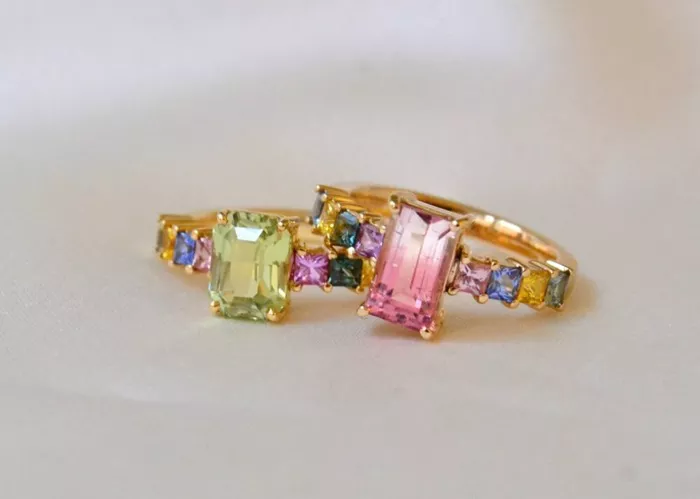Bi-color tourmaline is a fascinating and rare gemstone known for its distinct and vibrant color zoning within a single crystal. This unique gem showcases two or more different colors, creating a natural blend that captivates jewelry lovers and collectors alike. As a member of the tourmaline family, bi-color tourmaline shares the general properties of this diverse group but stands out due to its striking, multicolored appearance.
Tourmaline is a complex boron silicate mineral that comes in nearly every color of the rainbow. Its name originates from the Sinhalese word “turmali,” which means mixed gems. Among its many varieties, bi-color tourmaline is prized for its natural color transition, which happens during the crystal’s growth deep within the Earth.
This article will explore bicolor tourmaline’s geological origins, historical significance, cultural connotations, unique qualities, and its place in the jewelry world. Whether you are a gemstone enthusiast, jeweler, or collector, understanding the appeal of bicolor tourmaline can deepen your appreciation for this fascinating gem.
Historical Origins of Bi-Color Tourmaline
Tourmaline’s history dates back thousands of years. Ancient cultures in Sri Lanka, Egypt, and the Americas treasured tourmaline for its beauty and believed mystical properties. Bi-color tourmaline specifically began to attract attention in the late 19th and early 20th centuries when gemologists started to study its fascinating color variations.
The discovery of tourmaline in Brazil in the 1800s greatly increased its availability in the jewelry market. Brazil remains one of the primary sources of high-quality bi-color tourmaline today, along with countries like Nigeria, Mozambique, and Madagascar.
Early gem traders and jewelers were enchanted by the stone’s natural artistry — the way colors blend like a painting within the crystal was unlike any other gem. Over time, bi-color tourmaline gained popularity in fine jewelry as a symbol of nature’s complexity and beauty.
Meaning and Symbolism of Bi-Color Tourmaline
Bi-color tourmaline carries deep symbolic meanings across various cultures. The dual tones within one stone often represent balance, harmony, and unity. In spiritual and healing traditions, tourmaline is thought to protect the wearer, bring emotional stability, and enhance creativity.
The contrasting colors symbolize the merging of opposites, such as light and dark, or yin and yang. This symbolism makes bi-color tourmaline a popular gift for milestones like anniversaries or new beginnings, symbolizing growth through change.
Some also associate bi-color tourmaline with emotional healing. The color variation is believed to help balance mood swings and promote inner peace. Many holistic healers use it as a tool for chakra alignment and meditation.
Unique Qualities of Bi-Color Tourmaline
Color Zoning
The most distinctive feature of bi-color tourmaline is its natural color zoning. Unlike stones dyed or treated to create color effects, bi-color tourmaline forms naturally with two or more distinct hues. Common combinations include pink and green, blue and yellow, or purple and green.
These color zones can appear as bands, patches, or gradients, making every stone unique. This natural artistry is a hallmark of quality and a major reason bi-color tourmaline is so coveted in jewelry design.
Hardness and Durability
Tourmaline ranks 7 to 7.5 on the Mohs hardness scale. This makes bi-color tourmaline a durable option for everyday jewelry like rings, pendants, and earrings. It resists scratches better than many other colorful gems but still requires care to avoid hard knocks or harsh chemicals.
Pleochroism
Bi-color tourmaline exhibits pleochroism, meaning it can show different colors when viewed from different angles. This optical effect adds to its dynamic beauty, creating a shifting play of colors that changes with movement and light.
Clarity and Cut
While bi-color tourmaline often contains natural inclusions, these are usually not distracting and can even add character. Expert gem cutters work carefully to maximize the color contrast and brilliance, often opting for cuts like the emerald or oval to enhance color zoning.
Bi-Color Tourmaline in Jewelry
Bi-color tourmaline is highly valued by jewelry designers for its uniqueness and vibrant palette. Its natural color blend allows jewelers to create pieces that stand out with minimal additional decoration.
Popular styles include:
- Solitaire rings: Showcasing the gem’s natural colors.
- Statement pendants: Highlighting the stone’s size and color transitions.
- Cluster earrings: Combining multiple stones with complementary colors.
- Custom designs: Playing with metal colors (gold, silver, rose gold) to enhance the gem’s hues.
Its versatility means it can be set in both classic and contemporary designs, appealing to a wide range of tastes.
Caring for Bi-Color Tourmaline Jewelry
To keep bi-color tourmaline looking its best:
- Avoid prolonged exposure to strong sunlight, which can fade colors.
- Clean gently with warm soapy water and a soft brush.
- Store separately to avoid scratching other gems or being scratched.
- Remove jewelry before heavy physical activities or exposure to harsh chemicals.
Proper care will ensure the gem retains its brilliance and beauty for generations.
Conclusion
Bi-color tourmaline is a stunning gemstone that combines natural artistry with rich symbolism. Its dual colors and optical properties make it one of the most captivating gems in the jewelry world. From its geological origins deep within the Earth to its meaningful role in culture and fashion, bi-color tourmaline continues to inspire jewelers and collectors.
Choosing bi-color tourmaline means embracing a gemstone full of life, mystery, and natural elegance. Whether worn as a statement piece or cherished as a collector’s item, this gem remains a timeless symbol of nature’s beauty and balance.
Related topics:
- Paraiba Tourmaline: The Rarest Gemstone with Neon Beauty
- Elbaite: The Stunning Gemstone of Colors and Symbolism
- Michael M Jewelry Maintains Prices Despite Tariff Challenges


